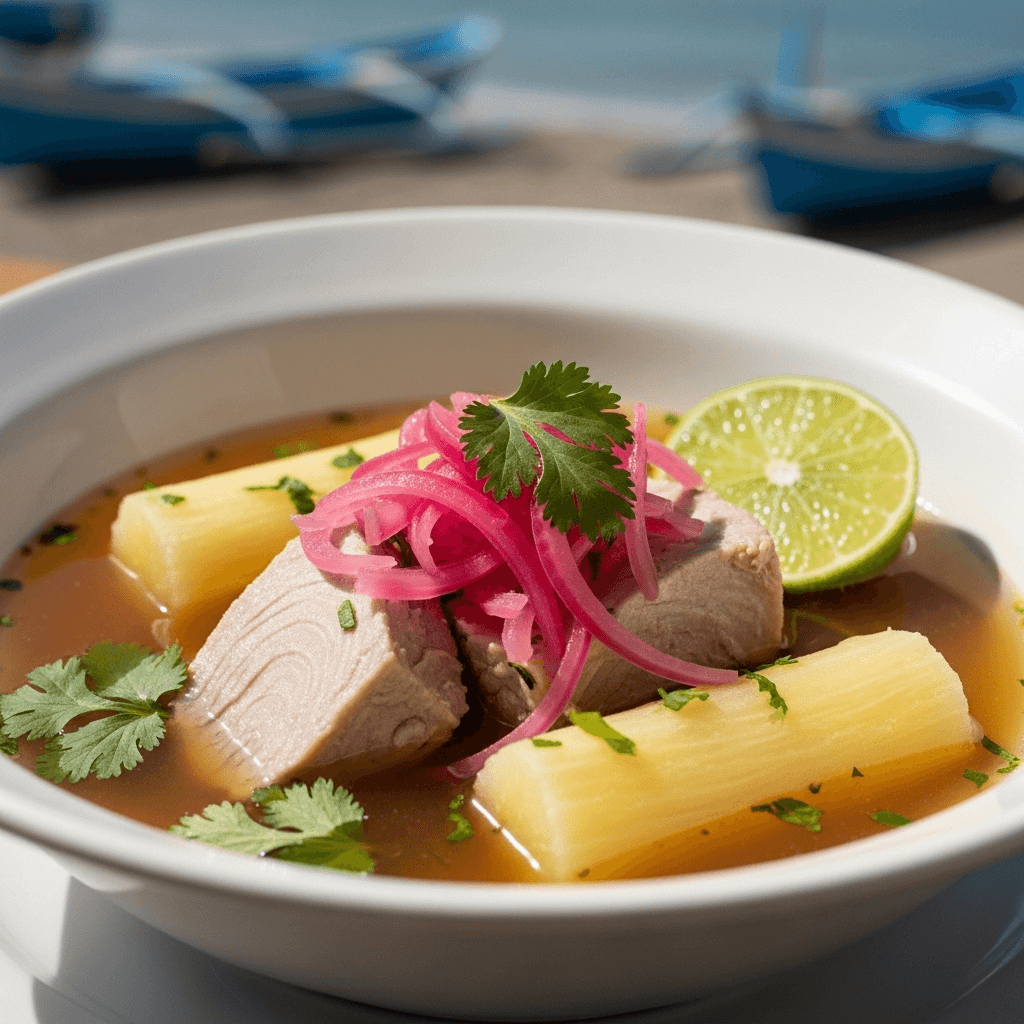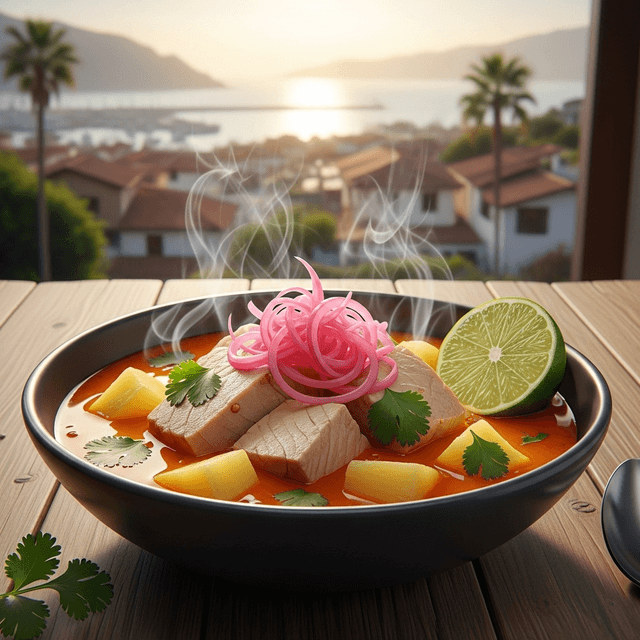I. Introduction: Dive into Ecuadorian Culinary Delights – The Encebollado Experience
A. Hook: The Scent That Awakens the Soul
Imagine this: you wake up, a little groggy perhaps, but then a vibrant aroma drifts through the air – a tantalizing blend of citrus, seafood, and warm spices. It's the unmistakable fragrance of Encebollado, bubbling gently on a stovetop, promising a fiery, flavorful kickstart to your day. For many Ecuadorians, this isn't just breakfast; it's a ritual, a remedy, and a taste of home.
B. Brief Overview of Ecuadorian Cuisine’s Diversity
Ecuador, a country blessed with incredible biodiversity, boasts a culinary landscape as diverse as its geography. From the Andean highlands with their hearty potato stews and roasted meats to the Amazon rainforest's exotic fruits and river fish, and the Pacific coast's abundance of seafood, Ecuadorian cuisine offers an exciting journey for the palate. It's a fusion of indigenous traditions, Spanish influences, and unique local ingredients.
C. Introduce Encebollado as a Coastal Star
Among this rich tapestry of flavors, one dish stands out as the undisputed king of the Ecuadorian coast: Encebollado. More than just a fish soup, it's a cultural icon, a beloved staple that embodies the spirit of the Pacific – fresh, vibrant, and bursting with life. Prepare to dive deep into the bowl that has captured the hearts (and stomachs) of a nation.

II. Unveiling the Encebollado: A Culinary Deep Dive
A. The Essence of Encebollado: A Hearty Elixir
At its heart, Encebollado is a rich, robust fish soup that delivers a powerful punch of flavor. It’s a thick, almost stew-like broth, deeply savory, with a delightful tang and a subtle heat. Every spoonful is a symphony of textures and tastes: tender fish, soft yuca, and that unforgettable bright acidity from the pickled onions. It’s warming, invigorating, and incredibly satisfying, a true embodiment of comfort food with an exotic twist.

B. Key Ingredients: The Pillars of Flavor
1. Fish Selection: The Oceanic Foundation
The star of Encebollado is undoubtedly the fish. Traditionally, White Albacore (Albacora) or Yellowfin Tuna (Atún) are the preferred choices, prized for their firm texture and ability to absorb the rich flavors of the broth without falling apart. Other suitable options can include fresh tuna varieties, ensuring the fish remains flaky and tender.
2. Yuca's Crucial Role: The Hearty Unifier
Yuca, or cassava, is the unsung hero of Encebollado. Boiled until perfectly tender, its starchy texture thickens the soup, lending it a comforting, substantial body. It acts as a perfect canvas, absorbing the delicious broth and providing a delightful contrast to the fish, making each bite incredibly satisfying.
3. The "Refrito": The Soul of the Broth
The foundational flavor of Encebollado comes from the "refrito," a sautéed base of finely chopped onions, tomatoes, bell peppers, garlic, and a blend of spices like cumin, achiote (for color and mild flavor), and oregano. This aromatic sofrito is slowly cooked until fragrant and slightly caramelized, creating the deep, savory heart of the soup.

4. The Star Ingredient: Pickled Onions – La Cebolla Encurtida
The crowning glory, and the origin of the dish's name ("encebollado" means "onioned"), is the generous topping of pickled red onions (cebolla encurtida). Thinly sliced red onions are marinated in lime juice, salt, and often a touch of cilantro and chili. Their vibrant color and sharp, tangy bite cut through the richness of the soup, adding a crucial layer of freshness and irresistible zest that defines Encebollado.
C. Regional Variations: A Taste of Coastal Diversity
While the core ingredients remain consistent, slight regional variations exist along Ecuador's extensive coastline. In some areas, more cilantro might be added to the refrito, or a touch more chili for extra heat. Certain locales might incorporate seafood like shrimp or conch alongside the fish, while others might favor a specific type of fish based on local catch. These subtle differences reflect the unique culinary personality of each coastal town.
III. Beyond the Bowl: Serving and Accompaniments
A. Classic Accompaniments: The Perfect Pairing
Encebollado is rarely served alone. Its traditional companions are essential for the full experience. Crisp, thinly sliced fried plantain chips (chifles) or thick-cut plantain fries (patacones) provide a crucial textural contrast and a satisfying crunch. A side of fluffy white rice is often served, perfect for soaking up every last drop of the flavorful broth. And, of course, a crusty piece of bread (pan) is ideal for scooping and savoring the soup's richness.

B. Modern Twists: Contemporary Flair
While deeply traditional, Encebollado has seen some modern interpretations. Some restaurants might offer a "mixto" version, combining fish with shrimp or other seafood. Creative chefs might experiment with different types of yuca preparations or introduce a unique garnish. However, the soul of the dish remains largely untouched, a testament to its enduring perfection.
C. Visual Appeal: A Feast for the Eyes
A well-prepared Encebollado is as beautiful to behold as it is delicious to eat. The vibrant red of the pickled onions contrasts beautifully with the light, flaky fish and the soft white yuca. A sprinkle of fresh cilantro, a drizzle of hot sauce (ají criollo), and perhaps a slice of avocado or a lime wedge complete the presentation, making it an enticing spectacle before the first spoonful even reaches your lips.
IV. Encebollado's Cultural Significance
A. Historical Context: From Humble Beginnings
The origins of Encebollado are rooted in the coastal fishing communities of Ecuador. It emerged as a practical and economical way for fishermen to utilize leftover catch, combining it with readily available staples like yuca and basic vegetables. Over time, it evolved from a simple fishermen's stew into the refined, flavorful dish cherished today, becoming a symbol of Ecuadorian identity.
B. Social Context: The Heart of Community
Encebollado is more than just food; it's a social glue. It’s the centerpiece of family breakfasts, a favorite at Sunday gatherings, and a go-to dish for celebrating holidays or simply enjoying a leisurely meal with loved ones. Street vendors, known as "encebolladeros," are a common sight across the coast, serving steaming bowls to eager customers from dawn until dusk. It fosters a sense of community, warmth, and shared heritage.
C. The Hangover Cure: The "Levanta Muertos" Legend
Perhaps its most famous cultural role is as the ultimate "Levanta Muertos" – the "raise the dead" remedy for hangovers. The combination of its hydrating broth, protein-rich fish, and the invigorating zing of lime and pickled onions is widely believed to rehydrate, replenish electrolytes, and revive even the most weary spirits after a long night out. Many Ecuadorians swear by its restorative powers, making it a Sunday morning pilgrimage for many.

V. Making Encebollado at Home: A Simple Recipe
A. Ingredient List:
- 1 lb (450g) fresh Albacore or Tuna, cut into 2-inch chunks
- 1 lb (450g) yuca (cassava), peeled and cut into large chunks
- 1 large red onion, thinly sliced (for pickling)
- 2-3 limes, juiced (for pickling + serving)
- 1/2 tsp salt (for pickling)
- 2 tbsp vegetable oil
- 1 large white onion, finely chopped (for refrito)
- 2 ripe tomatoes, finely chopped
- 1 bell pepper (green or red), finely chopped
- 4-5 cloves garlic, minced
- 1 tsp ground cumin
- 1/2 tsp ground achiote (or paprika for color)
- 1/2 tsp dried oregano
- 8-10 cups fish stock or water
- Fresh cilantro, chopped (for garnish)
- Ají criollo (Ecuadorian hot sauce), to taste
B. Step-by-Step Instructions:
1. Prepare Pickled Onions:
In a small bowl, combine thinly sliced red onion, juice of 1-2 limes, and 1/2 tsp salt. Mix well and set aside to pickle while you prepare the soup (at least 30 minutes).
2. Cook Yuca:
Place yuca chunks in a large pot, cover with water, and bring to a boil. Cook until fork-tender (about 20-30 minutes). Drain and set aside.
3. Prepare Refrito:
In a large pot, heat vegetable oil over medium heat. Add chopped white onion, tomatoes, bell pepper, and garlic. Sauté until softened and fragrant (about 8-10 minutes). Stir in cumin, achiote, and oregano. Cook for another 2 minutes.
4. Build the Broth:
Add fish stock (or water) to the refrito. Bring to a boil, then reduce heat and simmer for 15 minutes to allow flavors to meld.
5. Cook the Fish:
Add fish chunks to the simmering broth. Cook gently until the fish is opaque and flaky (about 5-8 minutes, depending on thickness). Be careful not to overcook.
6. Serve:
To serve, place some cooked yuca in the bottom of a bowl. Ladle a generous amount of fish and broth over the yuca. Top with a large spoonful of the pickled red onions. Garnish with fresh cilantro and a drizzle of ají criollo to taste. Serve immediately with chifles, rice, and/or bread.
C. Tips and Tricks:
Don't Overcook the Fish: Tuna and albacore cook quickly. Remove from heat as soon as it's opaque to keep it tender.
Mash Some Yuca: For a thicker, creamier broth, take a few pieces of cooked yuca, mash them, and stir them back into the soup.
Balance the Tang: Adjust the amount of lime juice in the pickled onions to your preference. A little extra lime can brighten the whole dish.
Quality Stock: Using a good fish stock will elevate the flavor significantly. If using water, consider adding a fish bouillon cube.
VI. Conclusion: A Final Taste of Encebollado
A. Recap: More Than Just a Meal
Encebollado is a culinary masterpiece that transcends its simple ingredients. It's a vibrant, hearty, and intensely flavorful soup, a testament to Ecuador's rich coastal heritage. From its tender fish and substantial yuca to the aromatic refrito and the zesty punch of pickled onions, every element plays a crucial role in creating this unforgettable dish. It's not just food; it's a cultural symbol, a source of comfort, and a trusted remedy.
B. Call to Action: Savor the Experience
Now that you've journeyed through the depths of Encebollado's allure, it's time to taste it for yourself! Seek out an authentic Ecuadorian restaurant near you and experience the magic firsthand. Or, if you're feeling adventurous, gather your ingredients and try your hand at making this iconic soup at home. Your taste buds will thank you!
C. Further Exploration: Beyond the Bowl
Encebollado is just one delicious facet of Ecuadorian cuisine. Once you've fallen in love with this coastal gem, explore other national treasures like Llapingachos (potato patties), Fritada (fried pork), or Ceviche (a lighter, citrus-marinated seafood dish often served with popcorn!). Each offers a unique window into the vibrant flavors and traditions of this incredible country. Happy eating!




